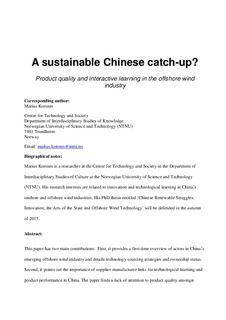| dc.contributor.author | Korsnes, Marius | |
| dc.date.accessioned | 2017-11-21T15:46:57Z | |
| dc.date.available | 2017-11-21T15:46:57Z | |
| dc.date.created | 2016-01-11T17:55:21Z | |
| dc.date.issued | 2016 | |
| dc.identifier.citation | International journal of technological learning, innovation and development. 2016, 8 (2), 172-196. | nb_NO |
| dc.identifier.issn | 1753-1942 | |
| dc.identifier.uri | http://hdl.handle.net/11250/2467417 | |
| dc.description.abstract | This paper has two main contributions: first, it provides a first-time overview of actors in China's emerging offshore wind industry and details technology sourcing strategies and ownership status. Second, it points out the importance of supplier-manufacturer links for technological learning and product performance in China. The paper finds a lack of attention to product quality amongst offshore wind industry stakeholders, and, as anticipated, time pressure and cost savings were important reasons for this. More surprisingly, the paper finds that the prevailing feedback practices between suppliers and manufacturers were unhelpful in ensuring product quality. This was particularly the case in two instances: when ties between the supplier and purchaser were too close (as was true for companies in the same industry group) and when ties were too shallow (as when turbine manufacturers 'shopped' for components, or when suppliers did not care about feedback from manufacturers). Feedback practices in large state-owned enterprises were particularly unfortunate, leading to missed learning opportunities. Unless such relationships are changed and catered for, Chinese firms will likely continue to struggle to catch up with frontier firms. | nb_NO |
| dc.language.iso | eng | nb_NO |
| dc.publisher | Inderscience | nb_NO |
| dc.title | A sustainable Chinese catch-up? Product quality and interactive learning in the offshore wind industry | nb_NO |
| dc.type | Journal article | nb_NO |
| dc.type | Peer reviewed | nb_NO |
| dc.description.version | acceptedVersion | nb_NO |
| dc.source.pagenumber | 172-196 | nb_NO |
| dc.source.volume | 8 | nb_NO |
| dc.source.journal | International journal of technological learning, innovation and development | nb_NO |
| dc.source.issue | 2 | nb_NO |
| dc.identifier.doi | 10.1504/IJTLID.2016.077112 | |
| dc.identifier.cristin | 1310395 | |
| dc.relation.project | Norges forskningsråd: 209697 | nb_NO |
| dc.description.localcode | © 2016 Inderscience Enterprises Ltd. This is the authors' accepted and refereed manuscript to the article. The final publication is available at https://www.inderscienceonline.com/doi/pdf/10.1504/IJTLID.2016.077112 | nb_NO |
| cristin.unitcode | 194,62,40,0 | |
| cristin.unitname | Institutt for tverrfaglige kulturstudier | |
| cristin.ispublished | true | |
| cristin.fulltext | original | |
| cristin.fulltext | postprint | |
| cristin.qualitycode | 1 | |
